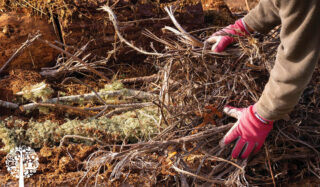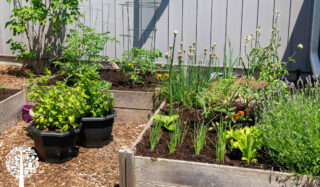As plants in containers grow, they use valuable nutrients in the soil that they cannot replenish naturally. As a result, they may need extra compost or fertilizer regularly. Ideally, you should transplant ornamental shrubs or roses growing in containers every few years to refresh the soil and replace lost nutrients. But hügelkultur containers change all this, creating permanent, self-watering, nutrient-rich, long-term homes for all plant babies.

Container Gardens & Hügelkultur
Generally, hügelkultur gardening systems create large raised or sunken garden beds by layering rotting wood and other organic material.
By applying the same method on a smaller scale, hügelkultur gardens can be created using containers. Many ingredients needed are already in your recycling bin, kitchen scraps, yard, or along a favourite walking trail.
The recipe for assembling a hügelkultur container garden is as simple as layering and baking a lasagna. There are no set measurements; like extra cheese in a lasagna won’t harm the outcome, adding more compost or fewer coffee grounds won’t ruin the hügelkultur container.
Ingredients
- One well-draining medium to large container with a diameter of no less than 25cm and a depth of no less than 30cm is optimal. The bigger it is, the more room for layering.
- A bunch of twigs, small pieces of rotten logs, or branches.
- A medium-sized tub of yard waste, compost, or dried leaves.
- Green organics; anything you would put into your kitchen waste or paper recycling bin, such as apple peelings, orange rind, eggshells, old tea bags, coffee grounds, paper towels and even cardboard.
- One bag of ordinary topsoil.
Layering
Start by covering the bottom of the container 1/4 to 1/3 full of twigs or small branches, and pack it together as tightly as possible. You only add this layer once.
Continue by adding:
- 2-5 cm of yard waste.
- 2-5 cm of green waste (kitchen scraps). Mix in cardboard or paper towel with this layer, if desired.
- Another layer of yard waste.
Repeat the process, depending on how large your container is, or until about 40% of it is filled. Smaller, shallower containers won’t require as much layering as larger, deeper ones.
Use a watering can or hose to moisten the assembled layers. It will look like you’ve filled a perfectly good container with garbage or a compost pile that hasn’t matured. That’s great because that’s what you’re supposed to be doing: creating compost in a container!
The top organic layers act as a reacting agent, akin to baking soda in a recipe, to begin the decomposition process on the bottom wood layer.
Once you’ve added all the layers, cover with ordinary garden soil and water again. Remember, this is where plant roots will establish, so keep plenty of room for this top layer.
Long-Term Rewards

A hügelkultur container will grow anything from vegetables and perennials to large shrubs or annuals. As the material in the container breaks down, microbial life and essential nutrients, such as potassium, phosphorous and nitrogen, are released into the soil and absorbed by plant roots.
The energy released by the decomposing material at the beginning of the process will keep the container’s temperature warm. In winter, this heat will help newly planted perennials or shrubs stay cozy and may even prevent the container from freezing solid.
Over time, as the organic material decomposes, topsoil must be added. But the decaying wood at the bottom will continue to act as a sponge, keeping roots nice and moist. As long as it’s well-draining, any container can have a long and useful life as a hügelkultur garden!